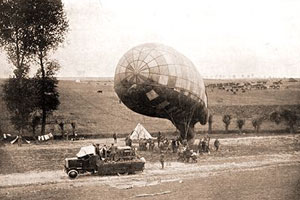Balloons on the Land
By Mike Bennighof, Ph.D.
September 2013
The turn of the last century marked a time of great belief
in the future. Science and technology would help usher in
a new age, and modern themes dominated art and literature.
An obsession with manned flight resulted in rapid advances
in both heavier- and lighter-than-air craft.
Military establishments took to these ideas only slowly, but in most nations
at least some officers sought to apply the new technologies
to war. In Russia, Capt. Fyodor A. Postikov, an army engineer,
experimented with balloons in and around St. Petersburg. With
his balloons, he found he could spot sunken ships in the Neva
River that could not be seen from the waterline. While these
experiments took place in the spring of 1904, war broke out
with Japan. Postikov suggested that a balloon detachment could
spot Japanese mines from the air and help protect naval bases
from secret mining, then an obsessive worry among naval planners.
The navy immediately took up his suggestion, and sent Postikov to the Far
East in command of a balloon detachment. Those intended for
Port Arthur never arrived (two were captured by a Japanese
cruiser while aboard a merchant vessel on its way to Manchuria,
and two others only made it by railroad after the Japanese
had broken communications between Port Arthur and Russia).
By the end of the war, Postikov commanded over 100 men and
nine balloons, four of them spherical craft and five Parseval-Sigsfeld
kite balloons.

An American kite balloon of 1907,
very similar to Postikovís.
Based at Vladivostok, the unit made 152 ascents during the war, but does not appear
to have achieved any useful results. One balloon was kept
on the transport Kolyma moored in Vladivostok harbor and raised
daily to check for overnight secret mining and to warn of
approaching enemy ships. When the war ended, the tsar ordered the balloon detachment
disbanded.
Denied their balloons, the Port Arthur garrison decided to
make their own. A small naval aeronautical detachment of 90
men led by Lt. M.I. Lavrov had arrived in advance of the equipment
to prepare for flights, before overland communication was
disrupted.
Lavrovís men managed to stitch together two gasbags,
but had trouble collecting enough sulfuric acid to generate
hydrogen gas. The home-made balloons could not carry a basket
and a man, and so the observer (Lavrov himself) had to be
strapped to the balloon in a harness. The two balloons were
lofted together on 12 August 1904, with Lt. V.V. Nell strapped
to the other one, but they do not seem to have made any aerial
discoveries.
Unable to generate enough gas for another attempt, the balloon
detachment had outlived its usefulness and was ordered into
the front lines as a naval rifle company. By 10 October Lavrov
and 76 of his men had been killed in action.

A dozen years and a continent away,
a British kite balloon takes flight.
Because we know fans love free downloads, we
have another one here. In operational scenarios in Great
War at Sea: Russo-Japanese War taking place in or before August 1904, the Russian player may
deploy one balloon at Port Arthur. Use the balloon mothership
rules for this balloon, but subtract one from the destruction
die roll. Once this balloon is destroyed, no others are available
at Port Arthur. In all operational scenarios, the Russian
player may deploy one balloon at Vladivostok. Once six balloons
have been destroyed, no more are available at Vladivostok.

In addition to the reconnaissance capability (which is not
that useful in a port zone), minesweeping attempts (13.73)
on sea zone boundaries adjacent to a port with a deployed
balloon are successful on a result of 3 through 6 rather than
4 through 6 (but explosions still happen on a result of 1).
Deploy your beautiful balloon! Click here to order Russo-Japanese War! |


